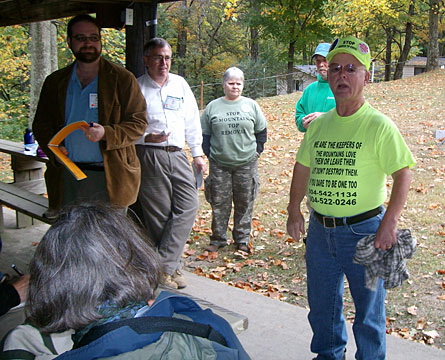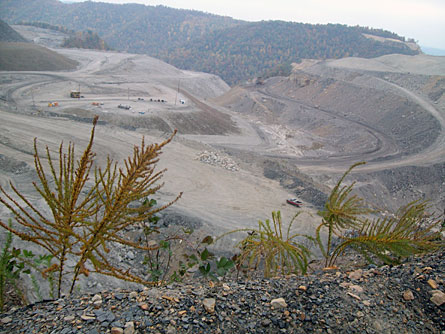Trading Forests for Coal
There’s plenty of talk these days about clean coal. Discussions typically focus on whether the mineral can be burned without spewing potentially dangerous quantities of carbon and mercury into the atmosphere. But in Appalachia, where the Society of Environmental Journalists has convened for its annual meeting, another issue is figuring prominently in the clean-coal debate: It’s mountaintop mining. And as it’s traditionally been practiced, mountaintop mining can be a remarkably ugly and culturally disruptive activity.


But aesthetics and social disruption aside (and I’m not arguing that they should be ignored), there can be big environmental costs to lopping off the top of a mountain in search of coal — something a busload of reporters witnessed Thursday on a field trip to coal country.
The hills of West Virginia are really mountains. Many have thin seams of coal running through them in horizontal bands — some just 12 to 18 inches thick. Until 30 or so years ago, mining most of the upper seams appeared hardly worth the effort. But with the United States’ growing appetite for coal (it now provides about half of U.S. electricity — more in many coal-rich states) pulverizing layers of rock with explosive blasts to expose narrow seams of coal has become a big and thriving industry.
Small teams of men blast the top of forested mountains into rubble, section by section. The resulting rocky “overburden” is then dumped into some nearby hollow (the local term for valley). And not just any hollow. Federal law says that overburden cannot be dumped into rivers or onto wetlands, which many hollows contain. (Lawsuits abound over whether and how well mine operators have complied with this law.)
The process exposes vast, flat vistas of rock. Daily detonations break up the stony strata. Big, multimillion-dollar front loaders scoop up the resulting boulders and drop them into huge, million-dollar dump trucks. When the coal is finally exposed, it’s scraped off, loaded into trucks, and transported by train or barge to steel plants, manufacturing facilities, or electric-power plants.
The whole mountain isn’t excavated, just the top several hundred to thousand feet. Four to 10 years after the blasting starts, mining teams leave. By law, they have to “reclaim” the newly flattened summits. In theory, that means recovering those scarred, planar surfaces with greenery typical of what would have covered the mountaintop before mineral extraction began.
In practice, we learned from a host of activists, university scientists, attorneys, and others, mountaintop reclamation often amounts to little more than seeding rock with a growth medium containing grass seed.
So the mountains have lost their formerly rugged, forested peaks. Their soil, trashed along with the upper rock layers, may take a thousand years to regenerate. Water runoff on largely denuded surfaces slows the evolution of grass and shrubby cover to woodlands.
It’s something we heard about in news sessions at our meeting and in the seemingly endless brochures and other types of propaganda being passed out in the meeting hallways by public interest and lobbying groups with names like ILoveMountains.org, Coal River Mountain Watch, and Keeper of the Mountains Foundation.
Keeper’s president, Larry Gibson, met with reporters to show them the mountaintop mining site on Kayford Mountain, roughly 35 or so miles from Charleston. It’s a place he knows well. He grew up on the mountain adjacent to where the mining now takes place and daily listens to detonations destroying the landscape.
Pointing to the neighboring scarred mountaintop, he notes that it once hosted a dense forest cover. None of the timber was ever harvested, he maintains. “I watched it, and it was just knocked over and buried.” A valuable resource, he contends it would have taken too much time and effort to haul out when it could just be treated like trash.
Understand, Gibson is mad. He tends to employ colorful language and probably more than a little hyperbole. But there’s ample evidence here and in reports, lawsuits and a growing library of newspaper coverage that environmental stewardship was not first, second or third on the list of concerns of many of mountaintop mining operators.
Moreover, we were told by a Virginia Tech mining consultant, the type of operation Gibson showcases on his mountain represents perhaps 95 percent of current mountaintop-mining projects.
Luckily, that researcher noted, a new trend is developing. And we would witness a good illustration of it a few hours later as we surveyed Pritchard Mining’s mountaintop clearing and reclamation efforts elsewhere in the state (see next posting). That second site suggests that at least some mountaintop-mining operators have begun trading in their black hats for ones in varying shades of gray. Some may even appear dove colored.
And that complicates immeasurably the job we journalists have in reporting on this industry and its impacts.





